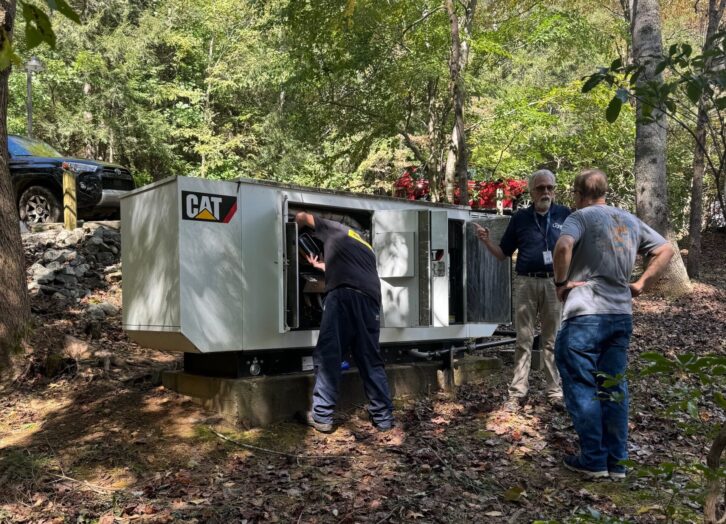The late-September impacts of Hurricane Helene were among the most significant events of 2024. What stood out most was the storm’s severe effects on the inland, mountainous terrain of western North Carolina.
We detailed the efforts of 570 WWNC(AM) and iHeart’s Asheville stations in delivering timely news and information to the region. One of the most powerful FM signals in the nation, 106.9 WMIT(FM), “The Light FM,” also played a critical role.
Superpower FM signal
Owned by Blue Ridge Broadcasting, WMIT’s transmitter is located atop Mt. Mitchell, the highest point east of the Mississippi River in the U.S. Its four-bay ERI Cogwheel antenna stands approximately 6,675 feet above sea level, operating with 36 kW ERP from a Rohde & Schwarz THR9 transmitter. The grandfathered power and height combination results in a coverage area that the former Duncan’s American Radio Guide surveyed as the 12th-largest of any U.S. FM. It features a hybrid format of contemporary Christian music and Bible teaching.
John Owens, The Light FM’s general manager, shared a video from its Mt. Mitchell antenna site in 2023:
View this post on Instagram
The Light FM’s main 106.9 signal was off the air for only five minutes total. Jim Kirkland, executive director of audio ministry for the Billy Graham Evangelistic Association, which operates Blue Ridge Broadcasting as a self-supported ministry, explained that the brief downtime was due to an oil change in the station’s studio generator.
All hands on-deck
The Light FM’s Helene story began during its twice-annual “Impact Days” pledge drive. As the flooding rains accumulated, the station pivoted away from the drive on the morning of Sept. 26, approximately 21 hours before the storm struck, to focus entirely on storm coverage. Kirkland described a rotating coverage schedule involving seven WMIT staffers.
They were its Doc Maranville, managing director of programming and content; David Harris, managing director for engineering; Carol Davis and Jeff Taylor, WMIT’s morning team; Tom Scott, afternoon host; Keith Pittman, technical and facilities manager; and Kelly Brandon, managing director for donor ministries. All but Harris went on-air regularly with information and encouragement.
“No one imagined this was the start of nine days of continuous coverage,” he told Radio World.
[Related: “Radio’s Resilience During Hurricane Helene Is Nothing New”]
Maranville oversaw the storm coverage and on-site operations. WMIT’s on-air team rotated between six and seven live on-air shifts, delivering updates every 30 minutes with the latest survival information from local authorities and relief organizations like Samaritan’s Purse. During the first three days after the storm, reports ran as long as approximately 15 minutes each.
“Our goal was to ensure listeners had all the information and encouragement needed to navigate a disaster of this magnitude,” Kirkland said. Staff members not on-site supported those at the studios by ensuring access to food and water.

Feeding Mt. Mitchell
The Light FM’s studios, located at the Billy Graham Training Center at The Cove, just east of Asheville, are equipped with a natural gas-powered generator that powers the entire building. Kirkland said the station has a separate building for its STL, which is a Marti analog 950 MHz. composite that feeds it audio up the mountain. He said the station is in the process of upgrading it to a Cambium IP link, under Harris’ engineering guidance. The front of its studios is shown below:
View this post on Instagram
Kirkland told Radio World the power lines running up to Mt. Mitchell were destroyed during the storm due to a landslide. On Dec. 27, exactly three months to the day since Helene struck, electricity returned to the Mt. Mitchell transmitter site via a temporary line installation. So far, it has proven completely reliable. “We’re prepared to return to the diesel-powered generators at an instant and prepared to operate continuously until further notice or once permanent lines are installed,” he said.
Internet connectivity to the station was restored within 36 hours of the storm using Starlink devices. As a result, no remote broadcasting was necessary. “It was a blessing to be fully staffed and fully operational at our studios,” Kirkland explained.

A beacon of positivity
Listener interaction was a hallmark of the station’s coverage, with frequent calls from those in impacted communities. “In the first days, there were countless stories of God’s power,” Kirkland said. While the need was evident, Kirkland said the generosity of those living in The Light FM’s listening area was, nevertheless, overwhelming. “The outpouring from listeners eased what was otherwise a tragic situation of a magnitude never before seen in the Blue Ridge Mountains,” Kirkland said. “Within days of a storm that took lives and livelihoods and washed away entire towns, hurting people had all the life essentials they needed.”

The Light FM is also broadcast on a 106.3 FM translator serving Asheville, which was off the air for over a week due to the lack of electricity at its transmitter site atop The Arras, the city’s tallest building. Other translators, including 94.9 FM in Winston-Salem, N.C., 101.5 FM in Rock Hill, S.C., 104.3 FM in Matthews, N.C., 101.3 FM in Cherokee, N.C. and 88.9 FM in Clemson, S.C. and full-power simulcasts on 106.7 WFGW(FM) in Norris, Tenn., 1150 WAVO(AM) in Rock Hill, S.C., 1150 WSNW(AM) in Seneca, S.C., and 1500 WSMX(AM) in Winston-Salem, N.C. remained on-air without interruption, according to Kirkland.
It took seven weeks to restore water to Asheville and the economic impacts of the storm are still unfolding. Hurricane Helene claimed the lives of 104 North Carolina residents and caused approximately $79 billion in damage.







